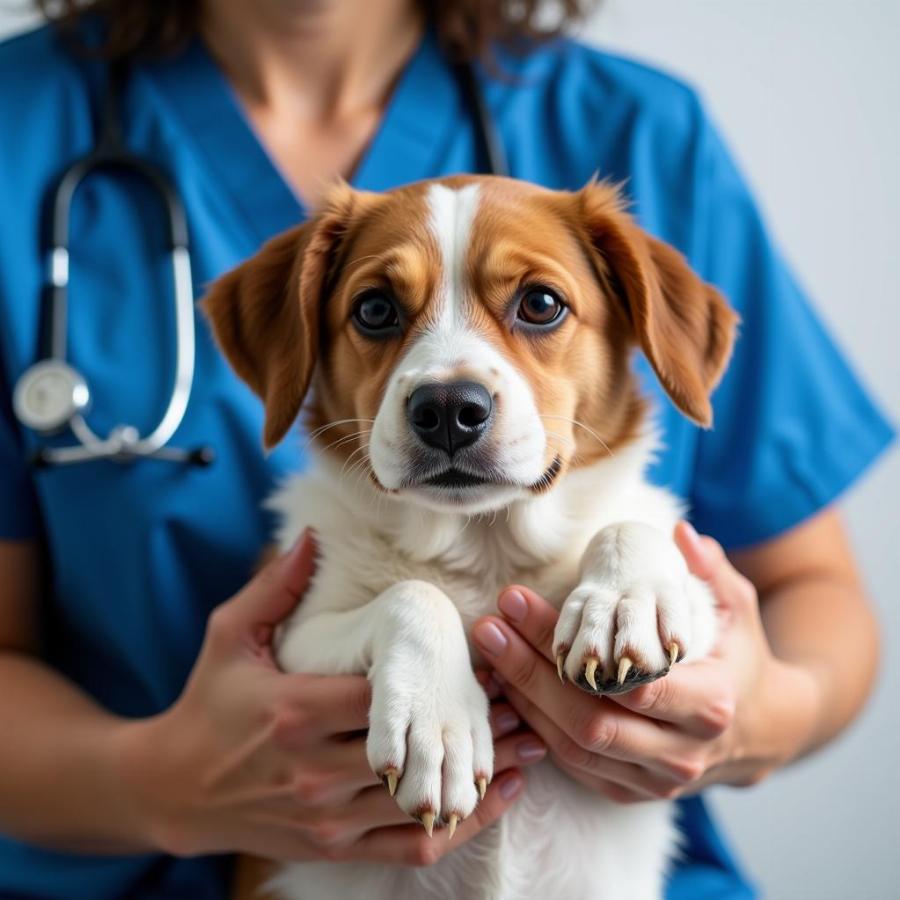Panting is a normal behavior for dogs. It’s their way of regulating their body temperature and cooling down. Just like we sweat, dogs pant to evaporate moisture from their tongue and lungs, which helps them release heat. However, if you notice your furry friend panting excessively or in situations that don’t seem to warrant it, there might be an underlying issue. This article will delve into the common reasons why dogs pant a lot, helping you differentiate between normal panting and potential health concerns.
Common Causes of Excessive Panting in Dogs
While occasional panting is completely normal, excessive and unexplained panting can be a sign of various factors, ranging from easily addressed issues to more serious health conditions.
Heat and Overexertion
The most obvious reason dogs pant is to regulate body temperature. If it’s hot outside, your dog has been exercising, or both, expect to see some heavy panting.
What to do: If you suspect heat is the culprit, immediately move your dog to a cool, shaded area and offer them small amounts of cool water. Avoid giving them large amounts of water at once, as this can lead to bloating.
Stress and Anxiety
Dogs primarily communicate through body language, and panting is one way they express stress, fear, or anxiety. Loud noises, unfamiliar environments, or separation from their owners can trigger anxiety-induced panting.
What to do: Identify and address the source of your dog’s anxiety. If possible, remove them from the stressful situation. Calming techniques like speaking in a soothing voice, offering a safe space, or using dog-appeasing pheromones can be helpful.
Pain or Injury
Just like us, dogs experience pain. Panting can be a sign your dog is injured or in pain. Keep an eye out for other symptoms like limping, whining, or changes in behavior.
What to do: If you suspect your dog is injured or in pain, it’s crucial to seek veterinary attention immediately.
 Veterinarian Examining a Dog for Pain
Veterinarian Examining a Dog for Pain
Medical Conditions
Several medical conditions can cause increased panting in dogs. Some common examples include:
- Heart problems: Heart disease can make it difficult for the heart to pump blood effectively, leading to fluid buildup in the lungs and difficulty breathing.
- Cushing’s disease: This hormonal disorder causes an overproduction of cortisol, leading to increased thirst, urination, and panting.
- Laryngeal paralysis: This condition affects the larynx (voice box), making it difficult for dogs to breathe properly.
- Anemia: A low red blood cell count can reduce oxygen delivery to the body, causing the dog to pant to compensate.
What to do: If your dog’s panting is persistent, accompanied by other symptoms like coughing, lethargy, loss of appetite, or pale gums, consult your veterinarian immediately.
When to Worry About Your Dog’s Panting
While panting is a normal canine behavior, excessive or unusual panting warrants attention. Here’s a quick guide:
Consult your vet if:
- Panting starts suddenly and your dog hasn’t been exercising
- Your dog is panting heavily even in cool temperatures
- You notice your dog’s gums are pale, white, or bluish
- Panting is accompanied by other symptoms like coughing, wheezing, lethargy, or loss of appetite
- Your dog’s panting seems labored or distressed
- You notice any changes in your dog’s normal breathing pattern
Keeping Your Dog Comfortable
Here are some ways to help prevent excessive panting and keep your dog comfortable:
- Maintain a comfortable temperature: Ensure your dog has access to shade and fresh, cool water, especially during hot weather. Avoid strenuous exercise during the hottest parts of the day.
- Manage stress and anxiety: Identify and minimize potential stressors for your dog. Create a safe and comfortable environment for them, and consider using calming aids like pheromone diffusers or calming treats.
- Regular veterinary checkups: Regular vet visits are essential for early detection and management of any underlying health conditions that might contribute to excessive panting.
Conclusion
Understanding the reasons behind your dog’s panting is crucial for their well-being. While panting is usually a normal physiological response, excessive or unusual panting can be a red flag for various health concerns. By paying close attention to your furry companion’s behavior and seeking timely veterinary care when necessary, you can ensure they live a happy, healthy, and comfortable life.
FAQs
Q: Is it normal for my dog to pant while sleeping?
A: Mild panting during sleep is generally normal, especially if your dog is dreaming or the room is a bit warm. However, heavy or labored panting during sleep could indicate a problem.
Q: Why does my dog pant after drinking water?
A: Some dogs pant after drinking water, especially if they drink quickly. This usually subsides within a few minutes. However, if the panting persists or your dog seems to have difficulty swallowing, consult your veterinarian.
Q: Can certain breeds of dogs pant more than others?
A: Yes, brachycephalic breeds (dogs with short noses and flat faces), like Bulldogs and Pugs, are more prone to breathing difficulties and may pant more than other breeds.
Q: Can medications cause panting in dogs?
A: Yes, certain medications, such as steroids and some pain relievers, can cause increased panting as a side effect. If you notice a change in your dog’s breathing after starting a new medication, consult your veterinarian.
Q: How can I tell if my dog is panting because of pain?
A: Pain-related panting is often accompanied by other signs like whining, restlessness, changes in appetite, or reluctance to move. If you suspect your dog is in pain, seek veterinary attention immediately.
You Might Also Be Interested In
For more information on dog health and care, check out these articles:
Need more assistance? Contact Beaut Dogs at [email protected] for detailed and accurate information.
Beaut Dogs is your one-stop destination for reliable and insightful information about the wonderful world of dogs. We provide a wealth of knowledge on dog breeds, care, and everything in between. Visit https://beautdogs.com today to learn more!